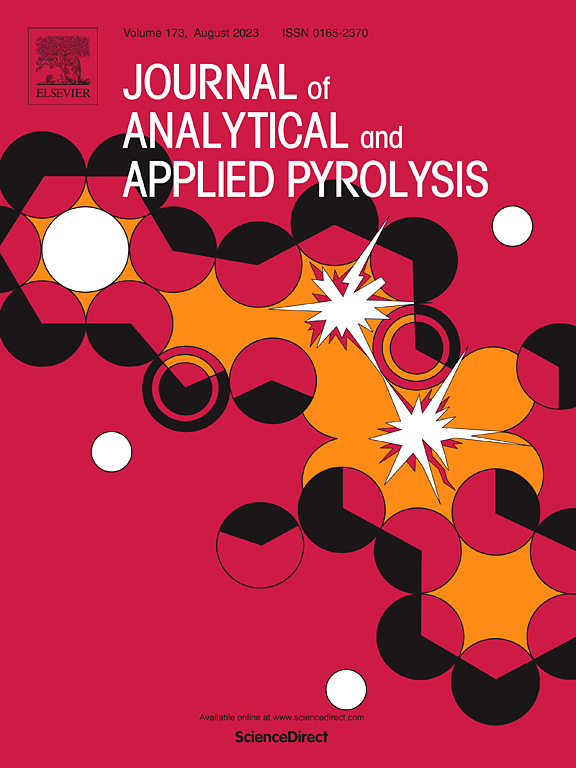低密度聚乙烯高温热解制氢和碳捕获
IF 6.2
2区 化学
Q1 CHEMISTRY, ANALYTICAL
引用次数: 0
摘要
利用低密度聚乙烯(LDPE)作为原料,非催化热裂解是一种很有前途的大规模制氢和碳捕获技术。此外,在此过程中产生的固体碳副产品的利用,提高了操作的经济可行性。这项工作使用模型化合物来揭示LDPE热解产生氢和捕获碳的潜力。实验室规模的高温固定床反应器在700°C至1600°C的温度范围内运行,LDPE颗粒直径为5 mm。尽管随着温度的升高,气产率下降到13.7 wt%,但从900°C到1600°C,氢产率显著增加,达到11.0 wt%。聚合物中大约三分之二的氢被鉴定为产物气体中的分子氢。在1600℃时,产生的氢气纯度为98.5 mol%,而在700℃至900℃的产物气体中主要含有甲烷和乙烯。温度对可冷凝产物相影响的分析表明,温度达到1000℃时,脂肪族和多环芳烃(PAHs)的产率增加。从1000°C开始,脂肪族和多环芳烃的产率下降可归因于气相通过形成固体碳而逐渐脱碳。此外,利用各种技术,包括TEM, SEM, DLS, TGA, XRD和拉曼光谱分析了所产生的固体碳。结果表明其作为可持续工业碳材料的潜力。本文章由计算机程序翻译,如有差异,请以英文原文为准。
High-temperature pyrolysis of low-density polyethylene for hydrogen production and carbon capture
Utilizing low-density polyethylene (LDPE) as a feedstock, non-catalytic thermal pyrolysis represents a promising technology for large-scale hydrogen generation and carbon capture. Furthermore, the use of the solid carbon byproduct generated during the process, enhances the operation’s economic feasibility. This work uses the model compound to reveal the potential of LDPE pyrolysis for producing hydrogen and capturing carbon. A laboratory-scale high-temperature fixed bed reactor is operated in the temperature ranging from 700 °C to 1600 °C, with LDPE pellets of 5 mm in diameter. Despite a decrease in gas yield to 13.7 wt% as the temperature increases, the hydrogen yield significantly increased up to 11.0 wt% from 900 °C to 1600 °C. Approximately two-thirds of the hydrogen present in the polymer was identified as molecular hydrogen in the product gas. At 1600 °C, a purity of 98.5 mol% was achieved for the hydrogen produced, while the product gas at temperatures ranging from 700 °C to 900 °C predominantly contained methane and ethylene. The analysis of the influence of temperature on the condensable product phase demonstrated an increase in the yields of aliphatic and polycyclic aromatic hydrocarbons (PAHs) species up to a temperature of 1000 °C. The decrease in yield of Aliphatic and PAHs from 1000 °C onwards could be attributed to the gradual decarbonization of the gas phase through the formation of solid carbon. Additionally, the produced solid carbon was analyzed using various techniques, including TEM, SEM, DLS, TGA, XRD, and Raman spectroscopy. The results demonstrated its potential as a sustainable industrial carbon material.
求助全文
通过发布文献求助,成功后即可免费获取论文全文。
去求助
来源期刊
CiteScore
9.10
自引率
11.70%
发文量
340
审稿时长
44 days
期刊介绍:
The Journal of Analytical and Applied Pyrolysis (JAAP) is devoted to the publication of papers dealing with innovative applications of pyrolysis processes, the characterization of products related to pyrolysis reactions, and investigations of reaction mechanism. To be considered by JAAP, a manuscript should present significant progress in these topics. The novelty must be satisfactorily argued in the cover letter. A manuscript with a cover letter to the editor not addressing the novelty is likely to be rejected without review.

 求助内容:
求助内容: 应助结果提醒方式:
应助结果提醒方式:


